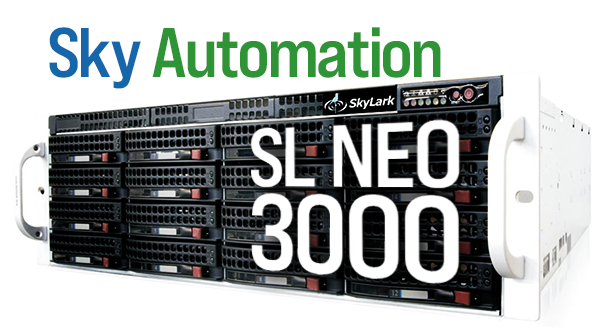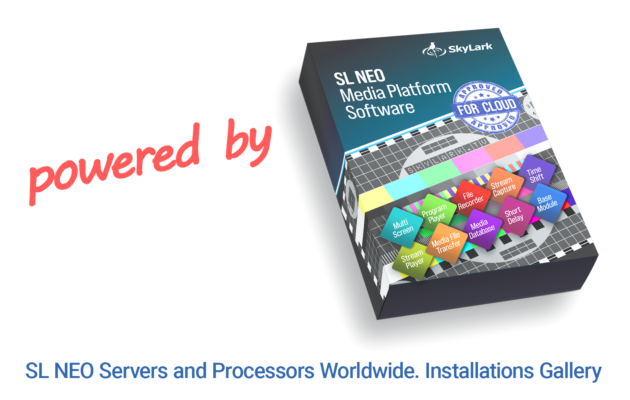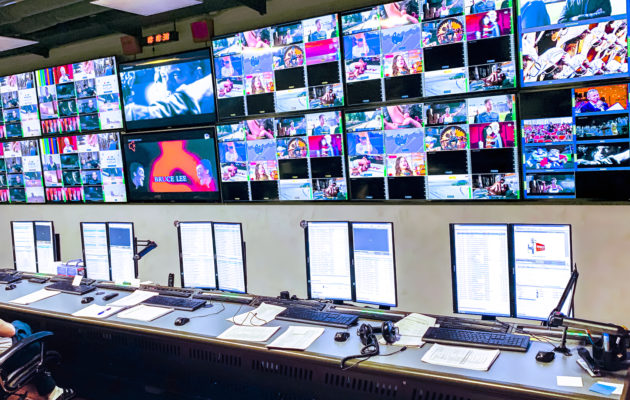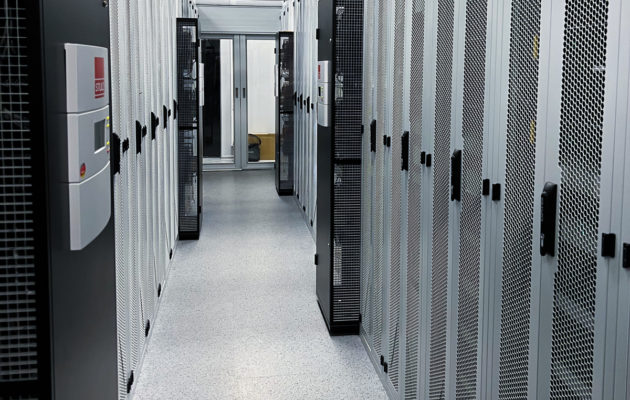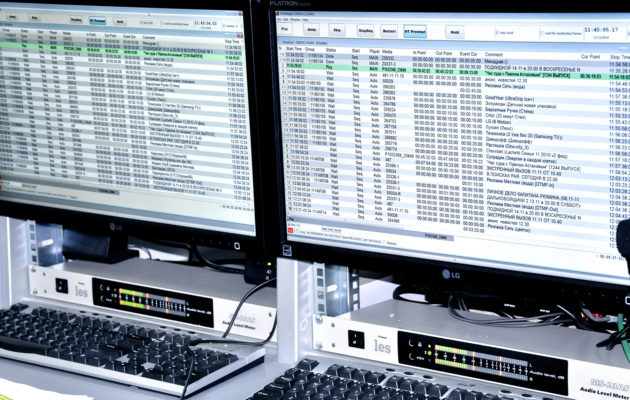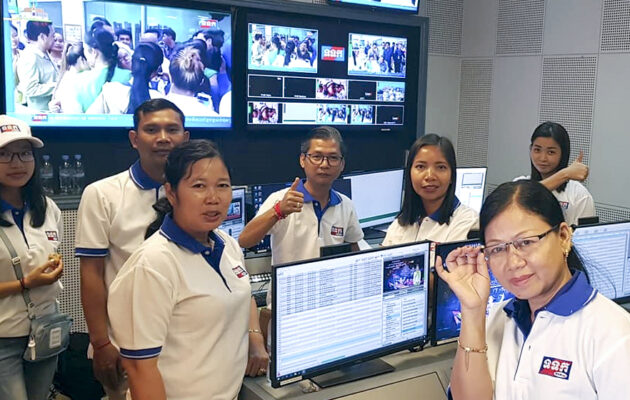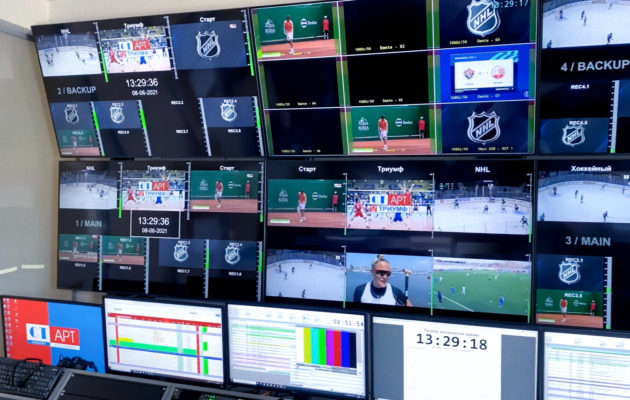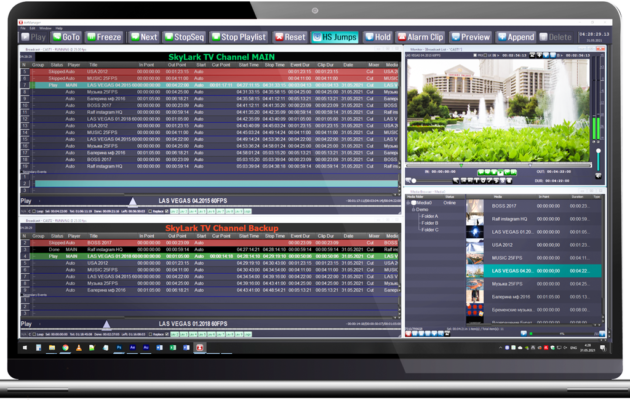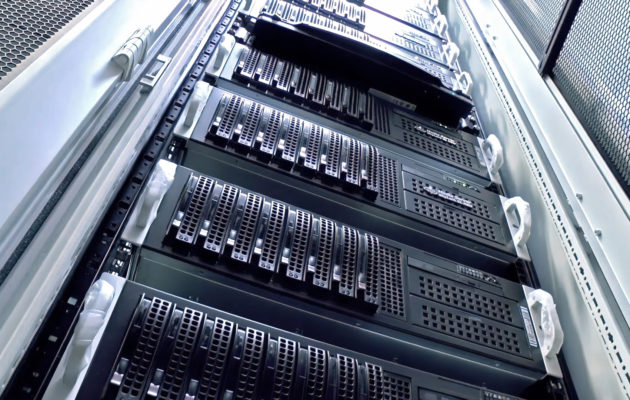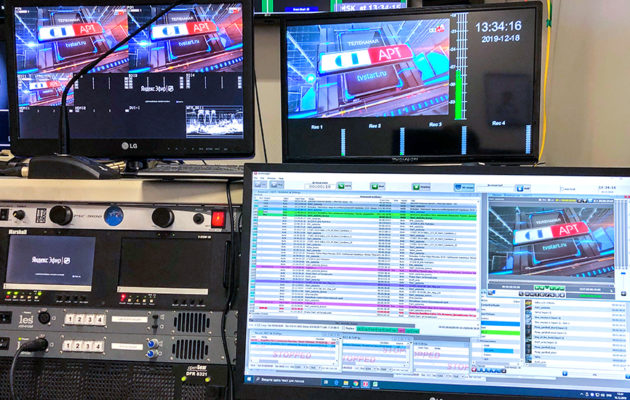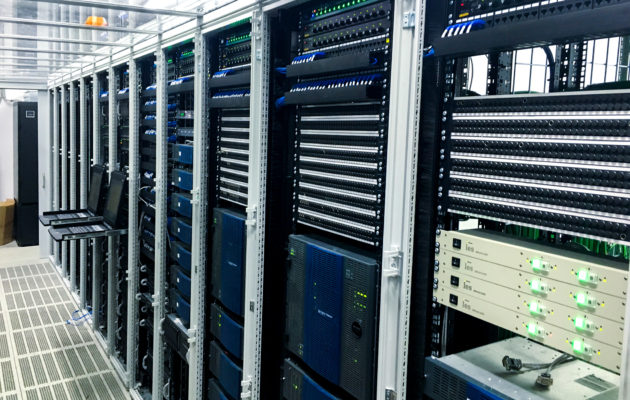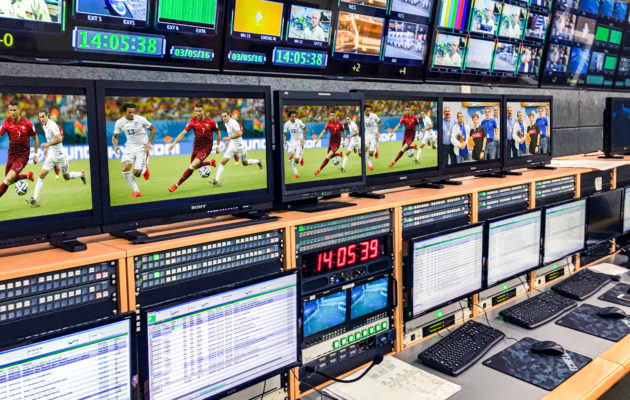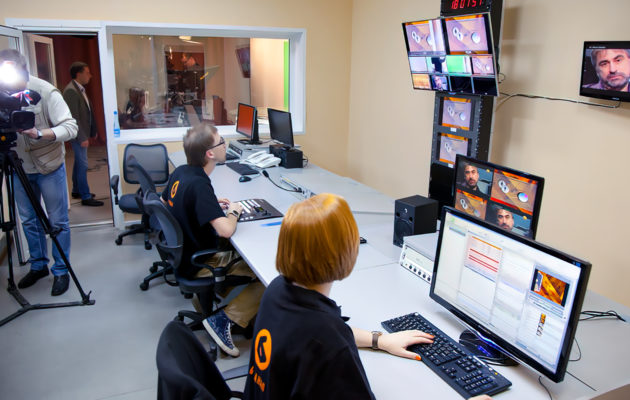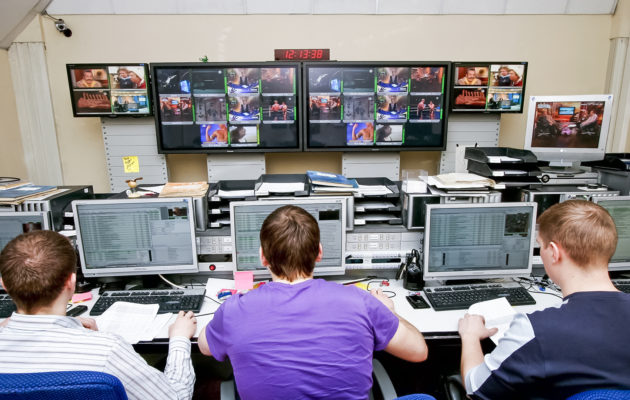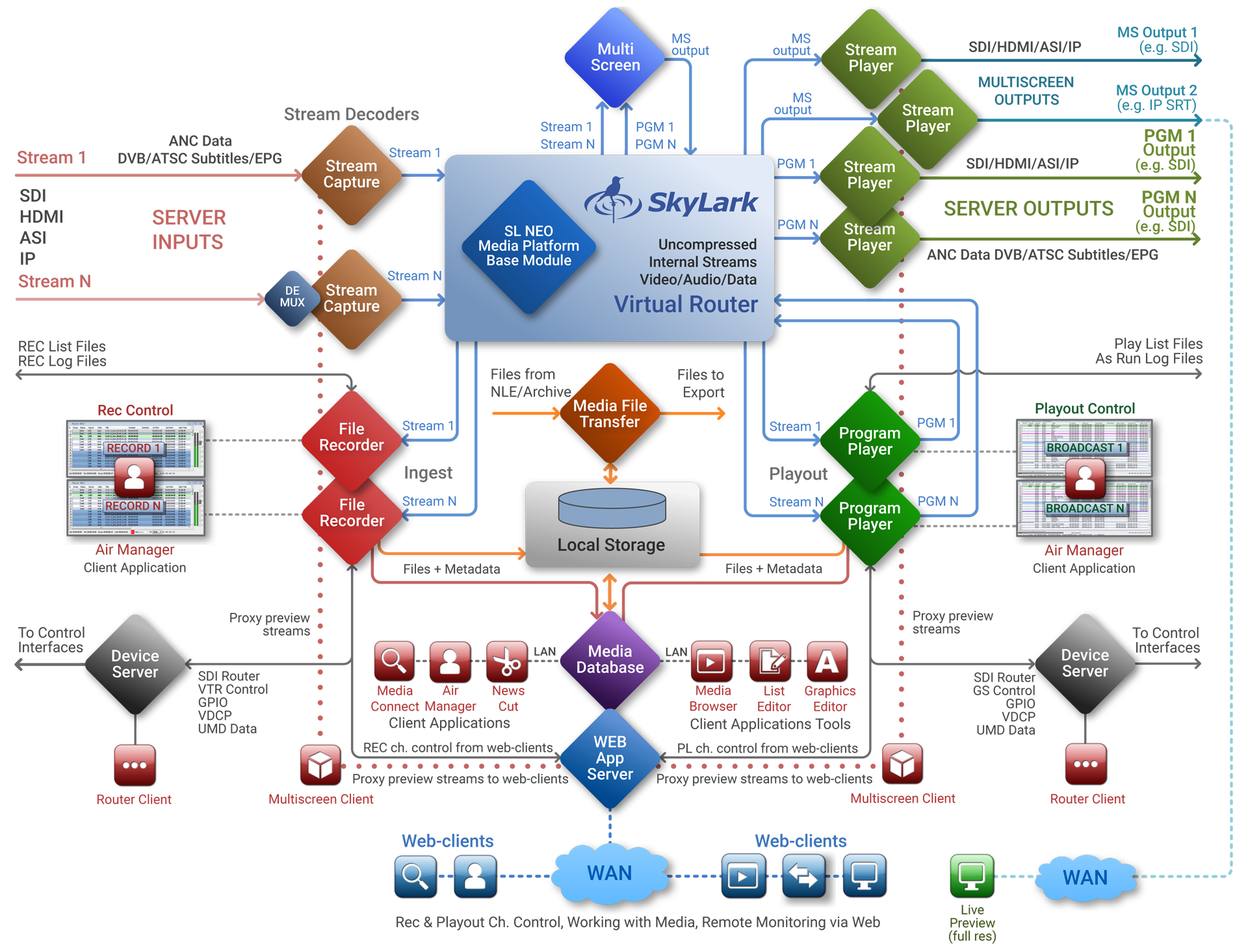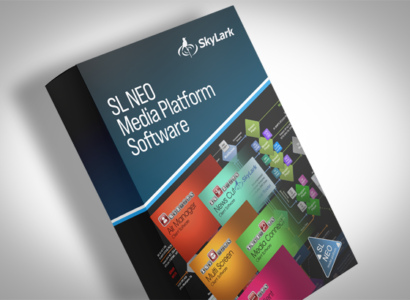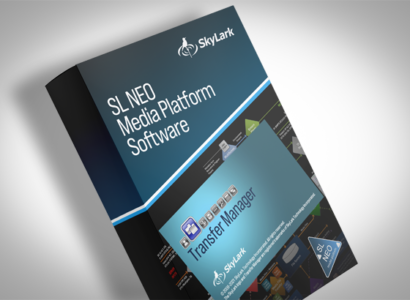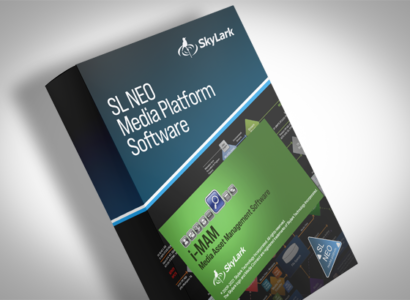Overview of the SL NEO 3000
The Linear Broadcasting Workflow consists of several Parallel Processes:
Live Ingest: Streams Capture & Recording
File Ingest: Transfer & Processing
- Stream Capture: demux, decoding of incoming Signals/Streams from SDI/HDMI, ASI/IP Interfaces. Types/protocols: SMPTE ST2110/2022−7, NDI, HLS, RTMP, RTP, UDP, SRT, Zixi.
- Up to 16x HD 1080i/p 50/60 or 4x UHD 2160p 50/60 Reconfigurable I/O Ports.
- Up to 8x (REC and PGM Reconfigurable HD Channels) or 4x (REC and PGM Reconfigurable UHD Channels) in one SL NEO 3000 Server (depend on model).
- Live Ingest: recording of Signals/Streams into Files according to Schedules, Rules and Rec Profiles.
- File Ingest: Manual or Automatic File Content Copying to Playout Servers, Copying and Moving Files between production units according to configurable rules.
Preparing: Сontent, Schedules, Graphics Templates
- Schedules: Import PlayLists and RecList Files from Traffic Systems, from Excel, scheduling in PlayList and RecList Editors.
- File Content: Search, Preview, I/O Points & Key Frames, Ad Points Settings, Proxy Fast Editing for News Stories.
- Graphics Preparation: Сreate and edit Graphic Compositions with titles, video, 2D DVE in Networked Graphics Editor.
Playout: Live Events and Files, On-air Graphics
- Automated according to Schedules or Manual Controlled Playout. Mix of File & Live Events (Input Streams from Server Capture Ports).
- Delayed Playback for Moderated Live Events.
- Graphics Layers Generation and Overlay: Lite or PRO Graphics Set.
- Lite Graphics Set: 1x GR Players and Character Generator plus a Logo Layer per one PGM Channel.
- PRO Graphics Set: 8x GR Players and Character Generators plus a Logo Layer per each PGM Channel.
- Automated Channel Branding or Manual Controlled Graphiscs Playback.
- «Secondary events» with markers in the Main PlayList per each PGM Channel.
Data Exchange (Control, CC, Text Visualization)
From External Systems and Devices:
- GPI, VDCP for SL NEO Rec or Playout Services Control in Slave Mode,
- CII Protocol for SL NEO Graphics Playback Control,
- Live Close Captioning Data from FAB and Polistream Systems,
- Data from Emergency Alert System (EAS) — National Warning System in the United States,
- Data to Text Visualization from External Sources (Weather Stations, RSS, HTTP).
To External Systems and Devices:
- SDI Routers for source switching for Rec or Playout Services (see Product Sheet for Supported Protocols),
- VizRT, Chyron Graphics Stations Control,
- Sony VTRs, Aidio Devices (Ember+), GPO Ports,
- TSL5/UMD Data for External Multiviewers.
SL NEO Control Protocol
During operation, Server Software Modules exchange commands with each other, receive and generate commands to external Devices and Systems via software and hardware control interfaces. The SL NEO Control Protocol allows the exchange of commands between:
- SL NEO Modules running on the same Server, or Modules running on multiple servers in a local network,
- SL NEO Servers & Workstations (XML-RPC Clients),
- SL NEO Servers, and External Systems which use SL NEO Control Protocol.
Media Data & Embedded Ancillary Data Processing
- Media Data (AV Streams): up/down/cross convertion (FPS, Color Spaces), Super White/Black Levels, Video Levels Ajust, Frame Sync, Output Loudness Normalization (R-128), Audio Levels Ajust/Normalization, DRC, Audio tracks mapping,
- ANC/MPEG2 Data Decoding, Recording, Generation, Retransmittion: VITC, AFD/WSS, Closed Captions, SCTE-104/SCTE-35/DTMF, DVB/ATSC Subtitles, EPG.
Media Files Processing
- During File Transfer Operations: up/down/cross convertion (FPS, Color Spaces), Output Loudness Normalization (R-128), Audio Levels, DRC, Audio tracks mapping, change Codecs and File Container.
Output Stream Encoding
- Streams Encoding with GPU Assistance. Data processng: ANC Data, DVB/ATSC Subtitles Insertion.
- Multiple Signals/Streams Outputs with a different resolutions/fps/protocols/bitrate per each PGM Channel (option).

Fault Tolerance in the Local Network or in the Cloud
- LAN and WAN Configurations: Built-in Media Database with proxy, Automated File Ingest, PlayLists Preparation and Control Tools, Web Application Server. All Playout (PGM) Channels are controlled and through SL NEO Client Applications when working in the local network or through Web-Clients when working in the WAN.
- SkyLark SL NEO Products is optimized for Amazon Web Services (AWS) to deliver comprehensive cost-efficiently Solutions.
- Redundancy Schemes from N+1 to N+N: hot redundancy: parallel running of half sets, on-line synchronization of all Backup Playlists from Main Server. Automatic Media DB mirroring, copying content from the Main Server to the Backup with tracking of changes in file versions.
Best Performance & Functionality
- SL NEO 3000 Performance is provided by two Intel Xeon Gold Server CPU, highly productive DDR4 RAM, and the disk subsystem based on hardware RAID from 8 to 16 Tb (depend on model).
- The Wide Functionality is Powered by the SL NEO Media Platform Software.
SL NEO 3000 Server Software Licensing
- Only the number of each Function type for Ports and Channels (Capture Ports, Output Ports, Recorders, Program Channels, Lite or PRO Graphics Set) and Formats (SD or SD/HD or SD/HD/UHD) are licensed.
- Any changing of Capture Port Interface type (SDI/HDMI/IP/ASI) and selecting for Capture Port any IP protocol from the list of supported, will not require additional licenses.
- Changing type of Output Port Interface (SDI/HDMI/IP/ASI) within the same category (uncompressed or compressed type), selecting any IP protocol from the list of supported for Output Port, will not require additional licenses.
- Increasing the number of Capture Ports, Output Ports or the number of Channels (Recorders, Program Channels), format changes to a higher resolution will invalidate the current license.
- To restore license validity, return the number of Ports, Channels and formats to their original values, or purchase an upgraded license that includes payment only for additional Ports, Channels and Format upgrades.
More Details
BASIC PARALLEL PROCESSES
- The SL NEO 3000 Servers is capable of simultaneously performing several basic parallel processes (both in automatic and manual modes):
— multi-channel recording of input signals according to schedules and rules,
— multithreaded automatic import and export of files,
— playback according to schedules, generation of multiple output programs,
— automated channel branding, closed and open captioning. - Related processes:
— Content Management,
— AV data/media files/ANC data processing,
— I/O Control commands processing,
— Main-backup processing.
THE WIDEST APPLICATION RANGE
- Operational production: 1). Live recording, fast editing, delayed playback. 2). Short Delay (profanity delay). 3). News Production.
- Central playout station: Вroadcasting to multiple Time Zones (SCTE/DTMF control markers generation for auto-replacement of ad/program blocks in regions.
- Regional playout station: decoding control commands in the signal from the central station, inserting of ad/program blocks. Commands to Start/Stop by results of matching a pre-selected fragment with fragments of the received video (in the absence of control signals).
- Cloud playout system: remote access and monitoring from WAN area. Management of recording channels, playback SL NEO 3000 server, access to the content through a web-browser (via Web Application Server).
ANY FILE/LIVE RESOLUTION AND FPS COMBINATION
- To switch and mix Live Sources signals into Output Programs, the SL NEO 3000 Server accepts input signals and streams of any resolution standards and fps values from Capture Ports.
- The same applies to the source media files: the resolution and fps settings of the file and the output program may be different.
- Up/Down/Cross conversions, buffering and frame synchronization of signals from Live Sources are required for program switching to be correct.
- Once the resolution, interlace mode, and fps parameters of the Live Sources and file player streams are identical to those of the output program, their switching and mixes will be clean and seamless.
- This also applies to Multiscreen display of signals of different formats on a single monitor.
CLOSED CAPTIONS, SCTE DATA PROCESSING
- CC Processing (from ANC Data, ASI/ATSC Subtitles):
— CC data capture, recording (embedded with audio and video),
— CC retransmission from server input to output,
— embedded CC playback from a recorded media file,
— CC generation use data from external live CC system (for live broadcast programs),
— CC generation from marked text files (for recorded programs, movies). - SCTE-104/35 Processing:
— SCTE markers capture, recording (embedded with audio and video),
— SCTE data decoding (use for internal commands generation),
— retransmission from server input to output (with cross-conversion between 104 and 35 formats),
— SCTE markers generation use ext. data (e.g. from PlayList lines attributes).
NO-FAILURE BROADCASTING
- Guaranteed no-failure broadcasting is provided by the «hot» redundancy scheme: the backup half-set works constantly and synchronously with the main one.
- Different schemes of backup from N+1 to N+N imply automatic synchronization of all playlists of the reserve server with the main one.
- Automatic copying of content from the main server array to the reserve one with tracking of file version changes, protection against accidental deletion of materials on the main server.
INTEGRATION WITH EXTERNAL SYSTEMS
- SL NEO Server Software directly integrated with Chyron and Vizrt Graphics Stations. External graphics are controlled from the main playout schedule.
- Integration with FAB, Polistream devices allows you to implement Automated Live Captioning for News, Sports and other live programming.
- SL NEO 3000 Servers are integrated with the U.S. Emergency Alert System (EAS), the National Public Notification System during a national emergency.
- Other Sysrems and supported Protocols:
— VDCP over IP (Slave mode for Single Rec/Playout Channel),
— SDI Routers for Rec/Playout Automation (more then 20 supported protocols),
— TSL5 UMD (Master mode for Single Device),
— Ember+ (for Junger Audio Devices. Master mode for Single Device).
OUTPUT STREAMS: ENCODING
- To distribute output programs in various environments, SDI/ASI/IP Streams with the necessary resolution/fps parameters, IP-protocols, and bitrates are generated at Server Output Ports.
- The procedure for creating a single output signal/stream is performed by the Stream Player software module.
- In Playout configurations, it receives uncompressed AV and ANC data from the Program Player module and then:
— encodes one compressed stream, sends it to the NIC/ASI port, or
— encodes one uncompressed data stream in SDI/HDMI format,
sends it to the Output Board, or
— encodes one uncompressed SMTE ST2110 stream, sends it to the NVIDIA NIC Output Port.
OUTPUT STREAMS: PROCESSING
- Each Stream Player module performs signal and data processing operations:
— up/down/cross conversion with ajusting video levels, changing frame rate and color space;
— loudness normalization in accordance with
EBU-R128 or audio levels normalization and
dynamic range compression;
— SCTE-104/SCTE-35/DTMF data multiplexing into the output stream, as well as CC data, AFD, WSS, VITC. - Within the system, several Stream Player modules works simultaneously, and their number is equal to the number of Output Ports.
Functional Diagrams
SL NEO 3000 Series Servers. Software Modules Types and Interconnections
File Import and Backup Sync Diagram for SL NEO 2000/3000 Series
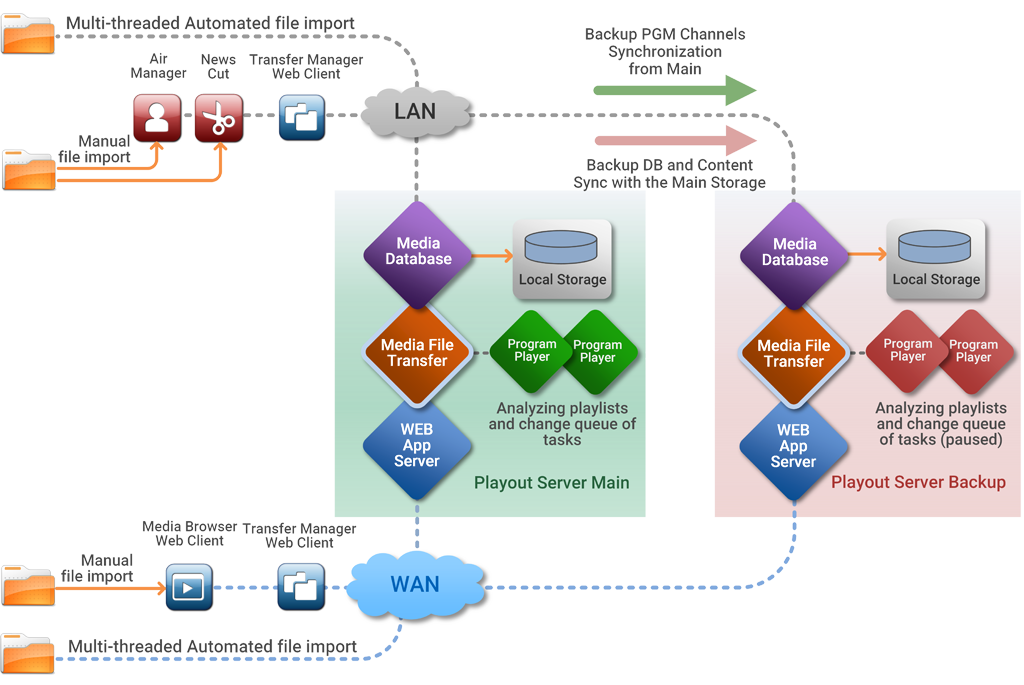
Stream Capture Software Module. Functional Block Diagram

File Recorder Software Module. Functional Block Diagram
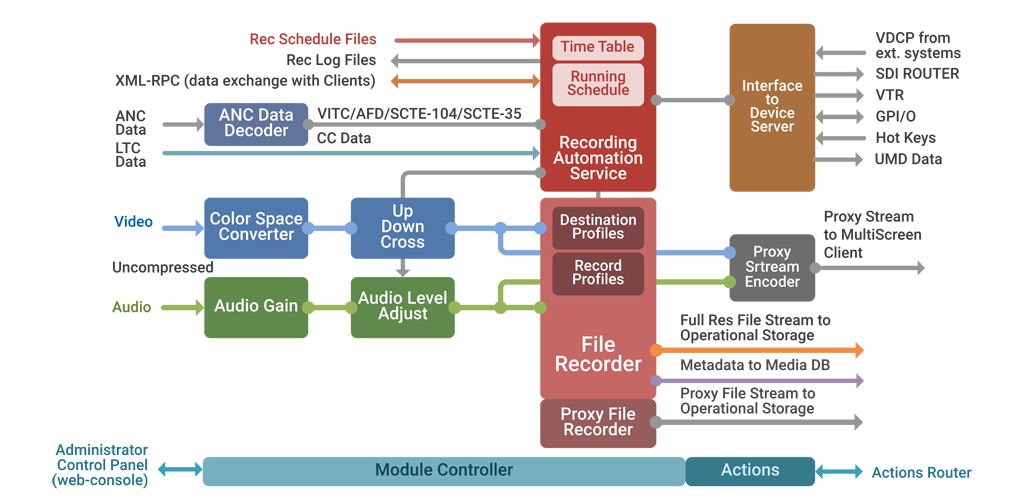
Program Player Software Module. Functional Block Diagram
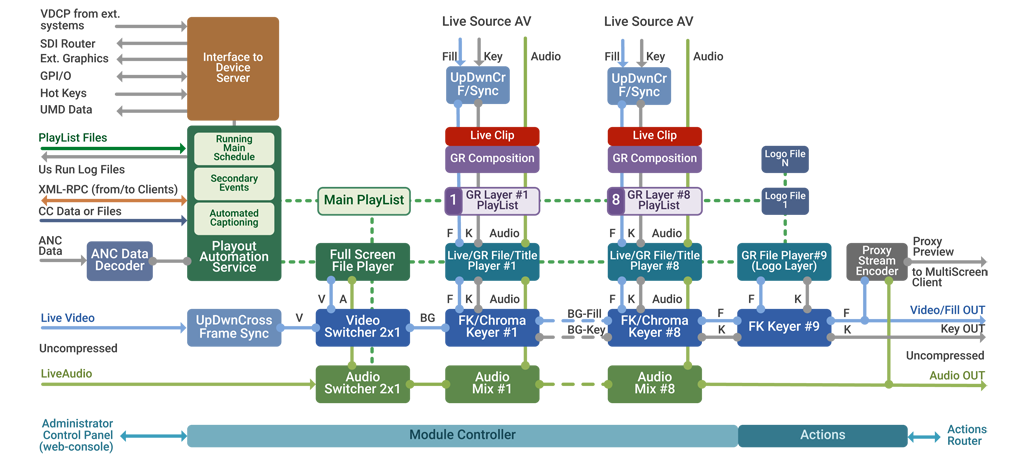
Multiscreen Software Module. Functional Block Diagram
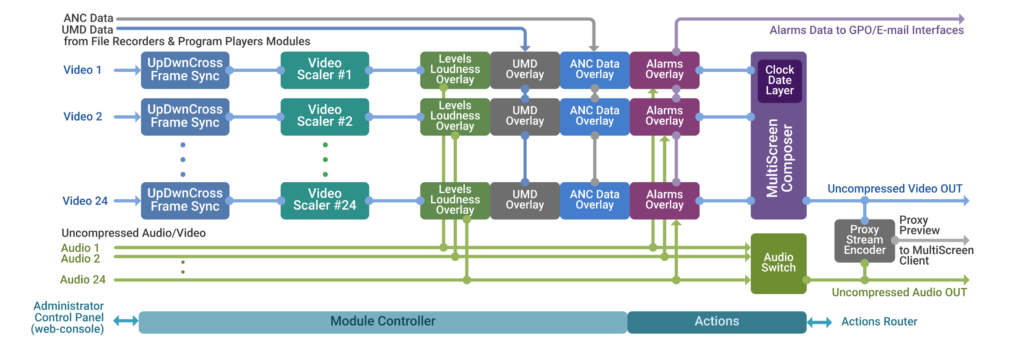
Stream Player Software Module. Functional Block Diagram

I/O Interfaces, Data, File Formats supported by SL NEO 3000
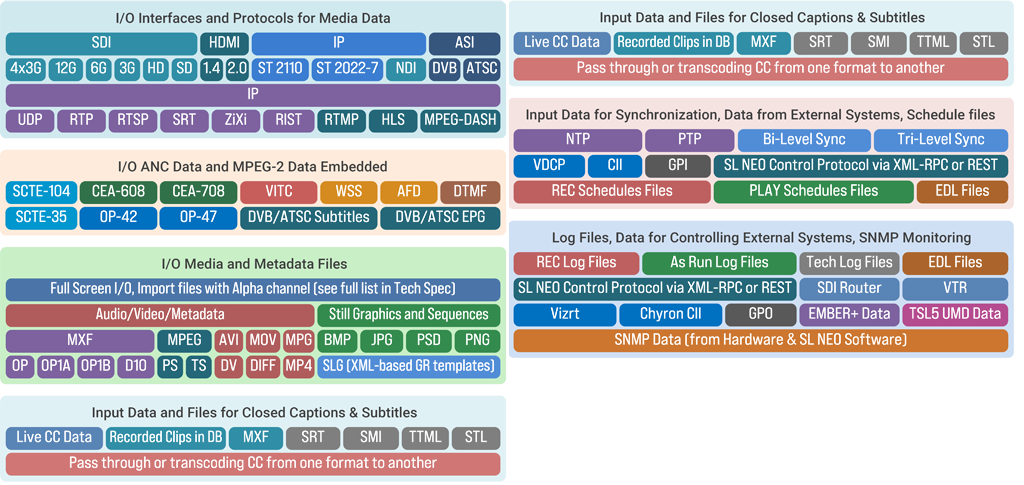
PDF Documents
SL NEO Servers and Processors. Models, Specifications & Features
SkyLark Technology Inc. About Company
F.A.Q.
Client Applications and more
News
